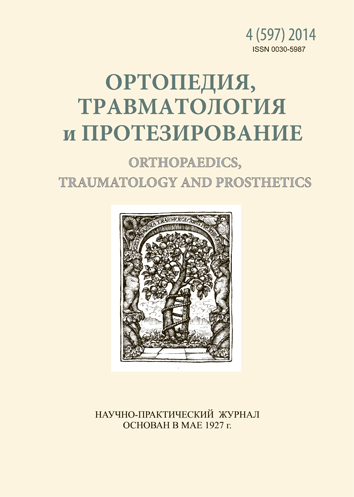The study of quality of life in patients with idiopathic scoliosis in distant postoperative period
DOI:
https://doi.org/10.15674/0030-59872014465-69Keywords:
ventral spinal fusion, posterior spinal fusion, idiopathic scoliosis, quality of lifeAbstract
Spinal deformity is one of the demonstrating diseases on example of which one may trace how treatment changes the patients' quality of life. By the final outcome of the treatment either the surgeon or the patient should be happy. However, comparative studies of quality of life in patients after ventral and posterior corrective spinal fusion (VSF and PSF) are absent. Purpose: based on subjective evaluation to explore and to compare quality of life in patients with idiopathic scoliosis after VSF and PSF in distant postoperative period. Methods: 36 patients with idiopathic scoliosis selected for the study we divided into two groups (18 persons in each). In the first group curvature correction was performed using VSF, and in the second — PSF. The criteria for inclusion in the group was the type of idiopathic scoliosis Lenke 1A and 5C, age over 12 years, performing short segmental VSF or selective PSF, consent of patients for examination within two years after surgery. To assess the quality of life we used the adapted and translated into Ukrainian and Russian language SRS-30 questionnaire. Results: It was found that the best overall average rating in outcome of treatment were given by patients of group VSF comparing to patients from the group PSF. In patients after VSF it was determined better outcome in 5–15 % an average. Statistically reliable difference between the values was found in the sections of psychological state (p = 0.091), pain (p = 0.028) and satisfaction with the treatment (p = 0.027). The overall average survey of patients in the first group was better by approximately 13 % compared with the second one. Conclusions: The performance of VSF in patients with idiopathic scoliosis provides the best on 13 % subjective outcome in distant postoperative period comparing with patients whom PSF was used in.
References
- Risk-benefi tassessment of surgery for adult scoliosis: ananalysis based on patient age / J. S. Smith, C. Shaffrey, S. Glassman [et al.] // Spine. — 2011. — Vol. 36 (10). — P. 817–824. DOI: 10.1097/BRS.0b013e3181e21783.
- Results of the Scoliosis Research Society instrument for evaluation of surgical outcome in adolescent idiopathic scoliosis. A multicenter study of 244 patients / T. R. Haher, J. M. Gorup, T. M. Shin [et al.] // Spine. — 1999. — Vol. 24 (14). — P. 1435–1440.
- Use of the scoliosis research society outcomes instrument to evaluate patient outcome in untreated idiopathic scoliosis patients in Japan: part I: comparison with nonscoliosis group: preliminary/limited review in a Japanese population / K . Watanabe, K. Hasegawa, T. Hirano [et al.] // Spine. — 2005. — Vol. 30. — P. 1197–1201.
Downloads
How to Cite
Issue
Section
License
Copyright (c) 2014 Dmytro Petrenko, Maksim Dolyanickiy

This work is licensed under a Creative Commons Attribution 4.0 International License.
The authors retain the right of authorship of their manuscript and pass the journal the right of the first publication of this article, which automatically become available from the date of publication under the terms of Creative Commons Attribution License, which allows others to freely distribute the published manuscript with mandatory linking to authors of the original research and the first publication of this one in this journal.
Authors have the right to enter into a separate supplemental agreement on the additional non-exclusive distribution of manuscript in the form in which it was published by the journal (i.e. to put work in electronic storage of an institution or publish as a part of the book) while maintaining the reference to the first publication of the manuscript in this journal.
The editorial policy of the journal allows authors and encourages manuscript accommodation online (i.e. in storage of an institution or on the personal websites) as before submission of the manuscript to the editorial office, and during its editorial processing because it contributes to productive scientific discussion and positively affects the efficiency and dynamics of the published manuscript citation (see The Effect of Open Access).














